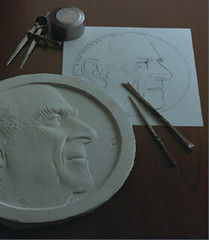
PREV ARTICLE
NEXT ARTICLE
FULL ISSUE
THE DESIGN OF MODERN BRITISH COINS
An article by Kevin Clancy in the January 2014 issue of Money & Medals neatly summarizes the design process for modern British coins.
Money & Medals is the numismatic publication associated with the Money
and Medals Network based at the British Museum and in association with
the RNS, BNS and a number of key partner museums.
-Editor
The design of modern British coins
The extent to which they change is summed up neatly by Sir Christopher Frayling, a former Chairman of the Royal Mint Advisory Committee on the design of coins and medals: ‘everyone has three things in their pocket or bag: keys, mobile phones and coins. Keys have remained much the same for hundreds of years, mobile phones are redesigned every month, while coins are somewhere between the two – nearer keys than phones’. Although only eight denominations of coins actively circulate, there are dozens of different designs but the process for obtaining and agreeing them is no less robust in every instance. The design Committee, of which Sir Christopher used to be Chairman, is now led by William Waldegrave and he is helped by lettering artists, sculptors, art historians, heralds, numismatists and representatives of the Royal Household. For any subject a number of artists, as well as members of the Royal Mint’s Design Department, will be invited to submit ideas, usually in the form of drawings or often these days as computer-generated designs. All the work is presented anonymously to the Committee, which meets about four times a year, and members come to a judgement on a short list of designs which are then developed into low-relief sculptures. Modern technology has made its presence felt at this stage, too, with designs increasingly being modelled on screen but for high-quality portraiture and more complex figurative compositions, traditional sculpting skills are more frequently required. A final decision is usually made at a subsequent meeting but it can take three or four sessions before a recommendation is put forward to the Chancellor and then to the Queen for approval. While coinage design historically was the preserve of engravers, the advent of the reducing machine, whereby larger scale models of a design could be copied and reduced to coin size, opened up the field to artists from other disciplines. Over time the diversity of those approached has expanded so that today the coins in your pocket could have been designed by a painter, wood engraver, jewellery designer, silversmith, graphic designer as well as by the more traditional discipline of sculpture. To make the point more clearly, last year the designers of the Olympic Torch, Ed Barber and Jay Osgerby, were behind the design of one of the two-pound coins issued to celebrate the 150th anniversary of the London Underground, while the talented young silversmith, Jonathan Olliffe, designed an impressive high-denomination coin to mark the 60th anniversary of the Coronation. Certain organisations, though, have played a key role over many years and that of the Royal Academy has been especially important. Well over a dozen Academicians have been involved in coin design projects in the last decade, with Tom Phillips being especially successful through his wonderfully intelligent Samuel Johnson fifty pence and more recently his design for another fifty pence, this time to celebrate the life and work of Benjamin Britten. Indeed, the Academy has been part of the history of the British coinage for over 200 years, providing coin designers in the shape of William Wyon, Thomas Brock, Edward Poynter, Gilbert Ledward and Arnold Machin to name but a few. To subscribe by email, contact: newsletter@moneyandmedals.org.uk
The Samuel Johnson fifty pence wowed me during my time in London in 2007.
While coin manufacturing techniques have changed greatly in recent years, the final product jingling in our pockets would be quite recognizable to time travelers from 300 years ago. Time will tell if electronic currencies ultimately win out, but keys are already changing. My car key is a hybrid. Hidden inside is an emergency physical key that will open and start my car in a pinch. But it's otherwise electronic, working magically without ever leaving my pocket.
That back-up physical key is hugely important, as I learned quickly the day the electronic key's battery ran out. One should always have a physical backup, which is why I recommend that anyone publishing a book electronically also have at least a few printed and sent to the major numismatic libraries. We live in an increasingly electrified world, but what's your personal backup when the lights go out? And what'll you do if they don't come back on after a few hours? Without a backup you're in deep doo-doo. I'm no survivalist, but I'm growing to appreciate "preppers" - people who prepare backup supplies of food, water, batteries, etc. in case of emergencies. Those who live in hurricane and snowstorm zones know the drill well, but everyone should be prepared in some way. My Christmas present to myself and family was a pair of standalone handheld radio/flashlights. They can be recharged by sunlight or cranking a handle, and have ports for recharging cell phones and other mobile devices, which we have far more of than people in our family. If you're looking for an interesting and thought-provoking read, consider the novel One Second After by William R. Forstchen (2011). I read it recently and couldn't put it down. Apocalyptic tales of space aliens and zombies don't interest me, but this book about a post-electricity world scared the bejesus out of me. -Editor
THE BOOK BAZARREWayne Homren, Editor The Numismatic Bibliomania Society is a non-profit organization promoting numismatic literature. See our web site at coinbooks.org. To submit items for publication in The E-Sylum, write to the Editor at this address: whomren@gmail.com To subscribe go to: https://my.binhost.com/lists/listinfo/esylum All Rights Reserved. NBS Home Page Contact the NBS webmaster 
|
